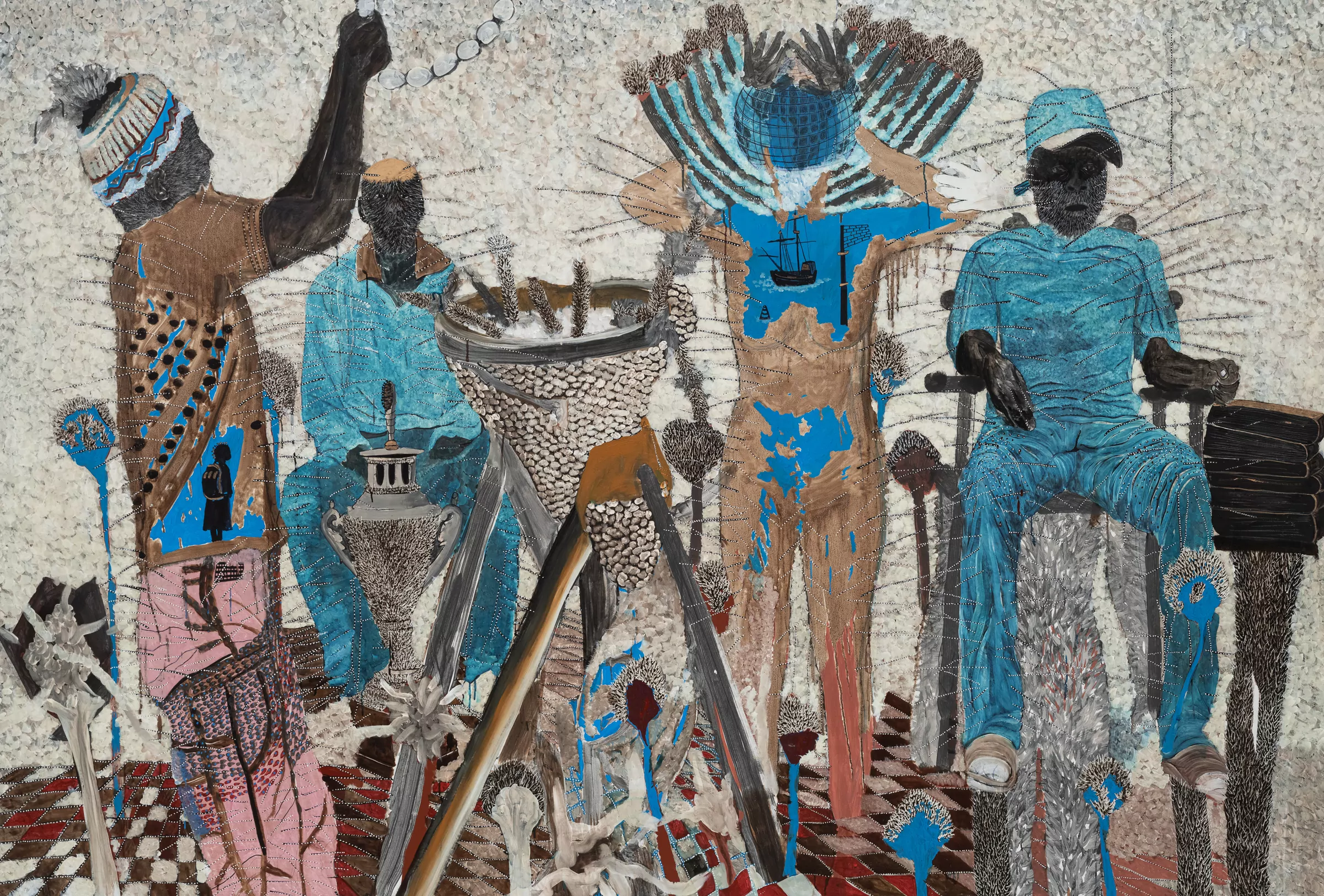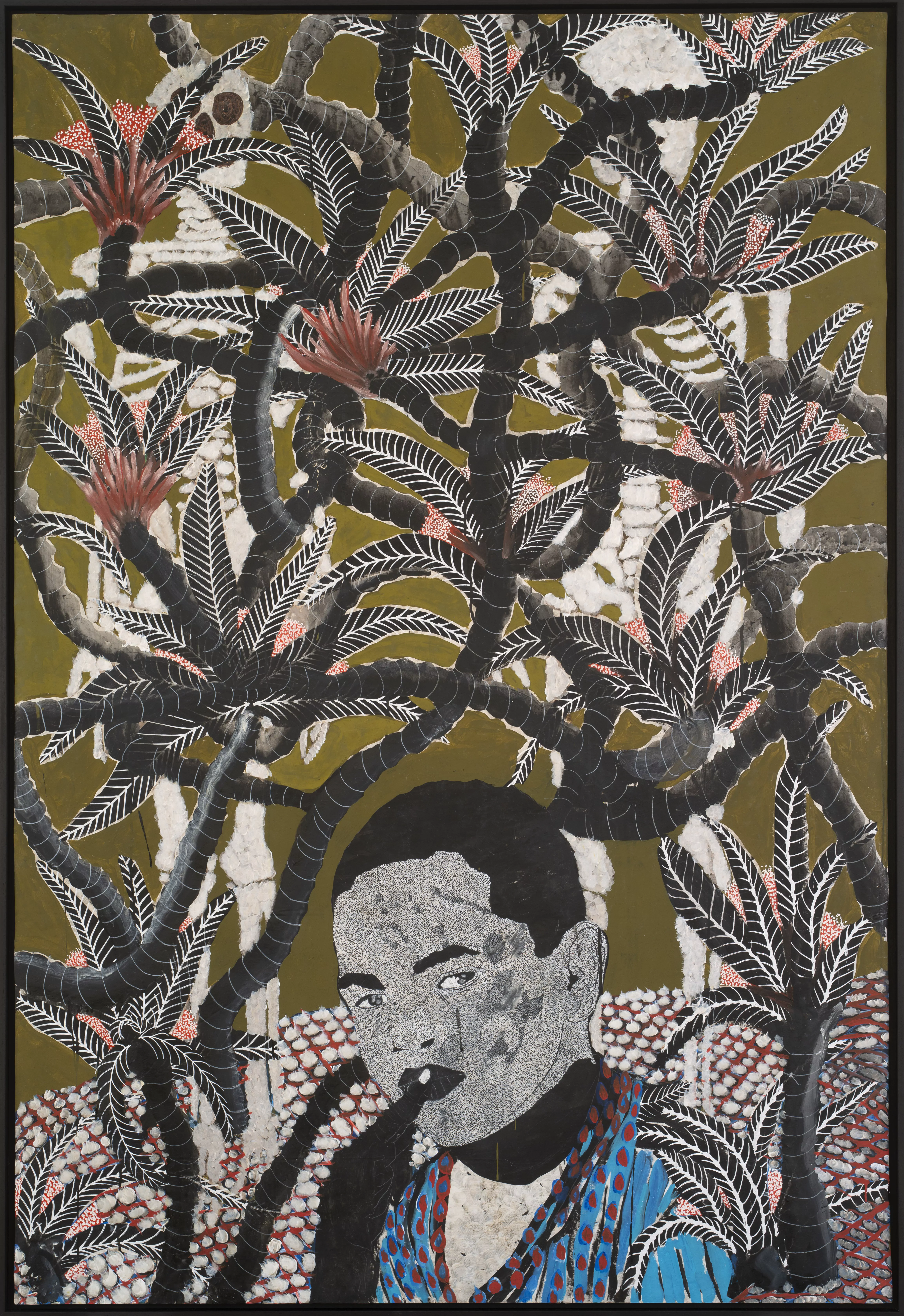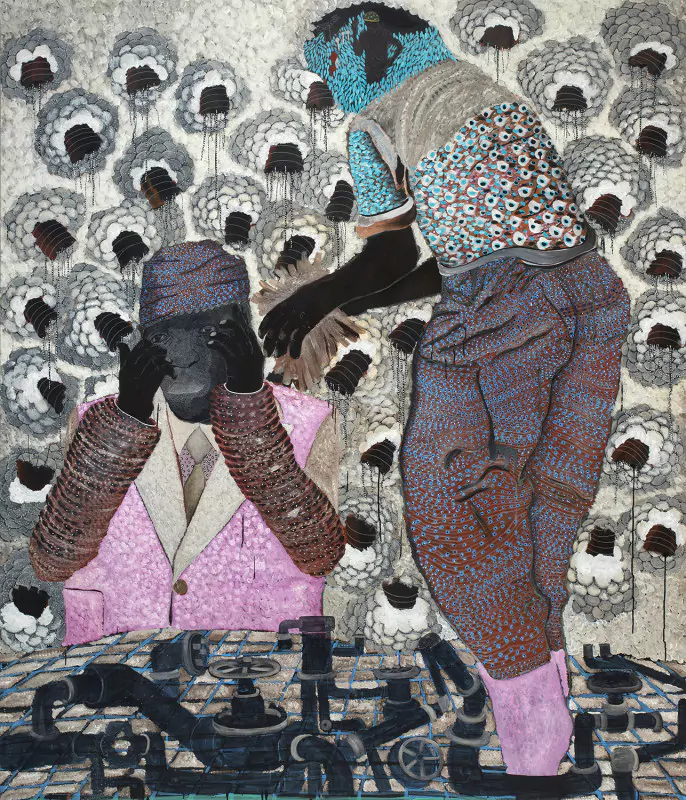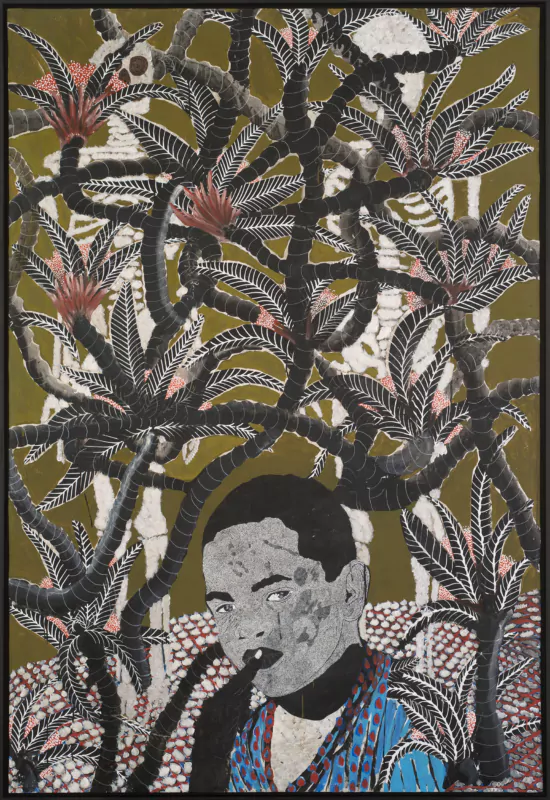
Omar Ba: Political Animals
Essay
Leslie Cozzi, curator of ‘Omar Ba – Political Animals’ at the Baltimore Museum of Art, addresses both the artist’s painting process and style as the themes of the exhibition – belonging, biopolitics, hybridity and power.
A dense network of electric blue cylinders crisscrosses a broad expanse of mottled white paint. Delicate, white-veined leaves sprout at their crossings, lending an organic quality to these enigmatic tubular forms. Small silhouetted figures sketched in white pencil lines occupy the negative spaces of this thicket. Some gaze out towards the viewer; others face the imaginary space of the canvas as if confronting a separate reality. Individuals, couples, children, parents—all stages of the life cycle are pictured in these groupings. The scalloped white lines surrounding these silhouettes amplify their energy. Like much of the work of contemporary Senegalese painter Omar Ba (born near Dakar, Senegal 1977), Eternal Resemblance 1, 2017, is an image of people bound together by forces outside themselves, and sometimes beyond their awareness. Yet the concept of affinity enacted in the formal structure of the work, and foregrounded in its title, contains a certain level of irony. For while we may see ourselves as individuals, we are defined by our relation to a wider group. These paradoxes of human nature and belonging take shape in Ba’s practice.

Ba’s painting process and use of materials embody his engagement with the local community. He typically works from photographs taken at home or around the Senegalese capital Dakar, capturing youth culture and daily life in its markets, streets, and beaches to constantly refresh his supply of visual information. From this influx of visual stimuli, he selects particularly evocative portraits of people and animals to print on colored paper and tack up to the studio wall. He makes multiple copies of these source images, sometimes blocking out the figure with thickly applied black paint to detach it from its original context and enable him to breathe new life into its painted avatar. He then experiments with different densities and opacities of color, working on multiple paintings concurrently and building up a subject layer by layer to produce a chimerical, monumental version of its former self.
Ba’s variegated colors and overlapping patterns appear to teem with life. Stylistically, this represents a major departure from the expanses of flat color often employed in representing the Black figure through the work of contemporary artists like Kerry James Marshall and others. Rather, Ba’s work has a remarkable tactility and dimensionality, not simply because of the undulating surface of the corrugated cardboard he regularly employs. Using a diverse array of wet and dry media (oil and acrylic paint, watercolors, inks, wax crayons, ballpoint pens, white correction fluid, pastels, and colored pencils), he achieves textural and chromatic effects that other artists often use beads, fabric, glitter, and appliqués to obtain. His paintings are built up of networks of short feathery strokes created, skeins of dripped or brushed color, and repeating circles and other details drawn in with pencils. He often works up the composition from a solid black background. This originated as a means of subverting the inherent racism of the Western canon, which for centuries has defined beauty as synonymous with whiteness. [1]
In the past few years, since his first sojourn in the United States in the spring of 2020, Ba has started experimenting with different grounds, including unprimed canvas. This more transparent surface enables the artist to capture spontaneous effects of paint and, in his words, “construct a technique from accident.” [2] Ba subsequently manipulates and superimposes different values of black on black and white on white. This tonal sophistication may be less immediately evident than his command of color, but it is arguably even more demanding. While he does not create precise, illusionistic replicas, his surfaces take on the physical qualities of the objects they depict—waxy, veined leaves; crepey, mottled skin.
Ba visualizes the precarious and dependent nature of EXISTENCE through the motif of the SPIDERWEB.
Layered on top of this black and white structure, a profusion of near primary color lends a lush, densely vegetational quality to Ba’s work. This is fitting for an oeuvre which so often thematizes the interdependence of people and environment. Ba’s work can be understood as a meditation on biopolitics, exploring how power defined in relation to biology exercises control over life and death. [3] The branchlike formations coursing through many of Ba’s compositions serve as a reminder of the shared linguistic derivations of the terms “roots” and “race” in both English and Ba’s spoken French. Yet if racism subdivides people and justifies violence by establishing “a biological caesura between the ones and the others,” [4] Ba instead emphasizes what he considers to be more important questions of connection and belonging.
The artist’s intricate visual systems are rooted in a palimpsest of personal and social history. Yet it is important to note that Ba’s work isn’t representative of the oversimplified version of African art—often elided with central and west African sculpture—widely accepted in the United States. [5] This has partly to do with the particularity of Senegal with respect to other nations on the continent. As the cosmopolitan former capital of colonial French West Africa, Senegal has long benefitted from and contributed to the global art market. Senegalese artists have worked internationally throughout the twentieth century, and Dakar boasts one of the longest-running and most important biennials in Africa. [6] Ba himself is the product of both Senegalese and Swiss art school training. So, it is not surprising that when discussing artists of interest, Ba cites Jasper Johns’ handling of materials and direct appropriation of political symbols; Andy Warhol’s engagement with the stuff of everyday life, from soup cans to political violence; and Chaim Soutine’s self-effacing yet visceral mastery of paint.
Ba describes himself as both Muslim and animist, noting that animism in western Africa predates both Christianity and Islam, and still inflects how Islam is practiced locally. Prior to his birth, his father had been Chief of Staff at the Ministry of Foreign Affairs in the government of Léopold Sédar Senghor. Senegal’s first post-independence president (1960–1980), Senghor was also a famous advocate of the anticolonial literary and philosophical movement that promoted an idealized conception of Black civilization known as Negritude. Yet Ba’s work does not champion cultural assimilation or hybridity as an unqualified virtue.

Voyage au-delà de l’illusion 2, 2022. Acrylic, India ink, colored pencil, porous tip pen, white correction fluid on canvas, 92 7/8 x 78 3/4 x 2 3/8 in.(236 x 200 x 6 cm)
Born in a Serer village outside of Dakar in 1977, Ba grew up in a Senegal marred by democratic failure and economic strife. Western-mandated fiscal austerity policies first applied in Senegal, then elsewhere in Africa, demonstrated the fragility of economies in newly formed, post-colonial nations. [8] The devastating toll of these programs was symptomatic of the economic and political problems Ba confronts in his work today—resource dependence, Western imperialism, and humanitarian failure. Africa’s misfortunes are not Ba’s sole focus, however. Ba’s frequent quotation of the United Nations’ emblem can be similarly understood as his critique of its patronage structure and ineffectiveness as a global peacekeeper. Much of Ba’s work addresses movement and migration, just as the spirals and undulating lines comprising his forms render it palpable. Sometimes Ba deals with migration in a mythic sense; elsewhere he treats its harsh realities.
Without stereotyping African art, how can we understand the particular challenge Ba’s work presents to viewers in the context of his first solo museum exhibition in the United States? [9] Famed Egyptologist and Senegalese anti-colonial activist Cheikh Anta Diop, in his landmark treatise The African Origin of Civilization: Myth or Reality, asserted, “Our investigations have convinced us that the West has not been calm enough and objective enough to teach us our history correctly, without crude falsifications.” [10] Deploying a similar logic, Ba’s paintings suggest that the West in turn might need to revisit its own history for the same reasons. With their disarming visual splendor, his images challenge assumptions about cultural superiority and political sovereignty deeply embedded in the European and American worldviews. They demonstrate, as Simon Njami points out, “The history of Europe in the past few centuries is an African history, whether one likes it or not. Just as African history is resolutely European.” [11] Ba’s frequent depiction of globes and his invocation of the Atlantic Ocean serve as reminders of our connectedness. They also implicate the specific responsibility of the United States, the later twentieth century’s reigning global superpower, within this unequal world order. In doing so, Ba challenges American exceptionalism, pointing to the ways in which our failures are world failures. Ba insists on the contiguity of seemingly disparate contexts, depicting in brilliant color the complex interrelation of all creation and the cycles of causality that produce a benighted present from a problematic past.

Bagdad 2006–Syrte 2011 (Baghdad 2006–Sirte 2011), 2018. Acrylic, oil, India ink, colored pencil, white correction fluid and gel pen on corrugated cardboard, 78 1/8 x 53 3/8 in. (198,5 x 135,5 cm)
‘Omar Ba-Political Animals’, Baltimore Museum of Art, until April 2, 2023.
Leslie Cozzi is Curator of Prints, Drawings, and Photographs at the Baltimore Museum of Art, where she is responsible for the post-1900 collection of works on paper. At the BMA, she helped design the museum’s “20/20 Vision” program, which highlights artists identified as women, and has organized several exhibitions, including the critically acclaimed survey “A Modern Influence: Henri Matisse, Etta Cone and Baltimore.” A 2017-2018 Rome Prize winner at the American Academy in Rome, she previously served as associate curator at the Grunwald Center for the Graphic Arts at the Hammer Museum (Los Angeles).
1.“At school we always had to paint on white based on the idea that we could see colors better, properly, and at a certain point I realized that is also ideology…starting always with white, with the idea that all that is clean is white and all that is dirty is black. I wanted to do the opposite. It is a way of showing the purity of blackness and also of rectifying history.” The artist quoted in Omar Ba: Same Dream, Power Plant Pages, no. 8 (Toronto: The Power Plant Contemporary Art Gallery, 2019): 73
2. Conversation with the artist, March 5, 2020.
3. In the opening lines of his essay “Necropolitics,” Cameroonian historian Achille Mbembe asserts that “the ultimate expression of sovereignty resides, to a large degree, in the power and capacity to dictate who may live and who may die.” Mbembe then goes on to explore historical expressions of biopolitical violence along with its more recent mobile and technological formations. Achille Mbembe, “Necropolitics,” translated by Libby Meintjes, Public Culture 15 (1): 11–40. For more on the application of biopolitics to African contemporary art, see Okwui Enwezor and Chika Okeke-Agulu, Contemporary African Art Since 1980 (Bologna: Damiami, 2009): 46.
4. Mbembe, “Necropolitics,” 17.
5. Christa Clarke and Kathleen Bickford Berzock, “A Historical Introduction,” in Representing Africa in American Museums: A Century of Collecting and Display (Seattle: University of Washington Press, 2011): 3–19.
6. Joanna Grabski, Art World City: The Creative Economy of Artists and Urban Life in Dakar (Bloomington: Indiana University Press, 2017): 2–6; Elizabeth Harney, In Senghor’s Shadow: Art, Politics and the Avant-Garde in Senegal, 1960–1995 (Durham: Duke University Press, 2004): 6–14, 34–38; Enwezor and Okeke-Agulu, 13.
7. Harney, In Senghor’s Shadow, 21–33
8. Enwezor and Okeke-Agulu, 19, 22 n 8, 341.
9. I am conscious, here, of the tokenizing tendency in globalized accounts of contemporary Africa: “So while artists may celebrate freedoms associated with globalism and transnationalism, such broader participation, detached from the markers of nationality and identity, is not without its contradictions. For it seems that, at the moment when African artists could present themselves as part of a denationalized global field of artistic production, their African-ness is reified.” Enwezor and Okeke-Agulu, 25.
10. Cheikh Anta Diop, The African Origin of Civilization: Myth or Reality, trans. Mercer Cook (Chicago: Lawrence Hill Books, 1974): xiv
11. Simon Njami, Africa Remix: Contemporary Art of a Continent (London: Hayward Gallery, in association with Hatje Cantz, 2005): 18.
